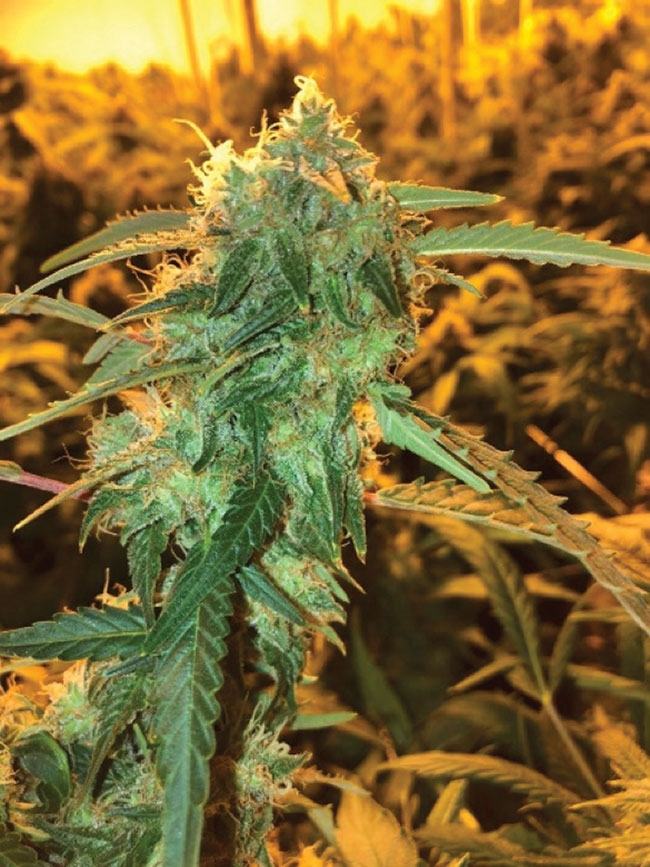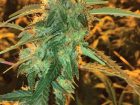
Features
Production
Nutrient needs of cannabis from rooting to harvest: Part one
Carbon dioxide
Sixteen elements are considered essential for proper growth of cannabis and these are the same as for other crops like tomatoes, cucumbers, peppers and lettuce. Out of these sixteen elements, carbon is at the top of the list and is required in large amounts. The carbon is taken from the air as carbon dioxide.
September 19, 2018 By Mohyuddin Mirza
 Well developed trichomes and good healthy leaves and buds with CO2 supplementation. Sixteen elements are considered essential for proper growth of cannabis
Well developed trichomes and good healthy leaves and buds with CO2 supplementation. Sixteen elements are considered essential for proper growth of cannabisI have seen cannabis crops being grown without any additional supply of carbon dioxide. The air which is brought in the greenhouse or indoor facilities contains about 400 parts per million (ppm) of CO2 and it can be depleted if fresh air is not brought in. Cannabis plants growth will slow down at 300 pm and will stop growing if CO2 levels drop below 200 ppm. In an indoor situation the growers have to be very careful if CO2 burners are used as a source of carbon dioxide. A supply of fresh air is needed for such burners, otherwise unwanted carbon monoxide, nitrogen dioxide and ethylene can build up to cause damage to plants and to buds when resins are being formed in trichomes. My preference is to use liquid CO2 in indoor facilities.
Ideal CO2 for cannabis
Light energy is used to fix CO2 and water inside the leaves. One should have proper information on how much CO2 should be used. Many recommendations are to go as high as 1,500 ppm and the assumption is that the higher the CO2, the higher will be the production. In my experience, staying close to 800 to 1,000 ppm is ideal. Basically, we want to make sure that CO2 is not depleted in the grow area, and also providing additional CO2 so that higher photosynthetic rates are achieved. That means more biomass production and better quality.
What plants need
To enable the plant to use CO2 properly, ensure following aspects are taken care of:
CO2 is only added when light is available. Cannabis plants photosynthesis peak is early in the morning when sunlight is received by the plant, so many growers will start adding CO2 an hour before sunrise so that the levels are at the range when light hits the crop. In case of indoor production, CO2 can be turned on a few minutes before light is turned on. Remember, plants produce CO2 during dark period so it is quite possible that you don’t need to add CO2 first thing in the morning. Monitoring of CO2 levels is essential.
Stomata fully open for the CO2 to get inside the leaves. These are the openings under the leaf surface, which basically regulate gas exchange in plants. Moisture is lost through these stomata and CO2 diffuses in.
Stomata open properly when plant water system is fully charged and enough potassium is available. So make sure that before light is turned on in indoor situations, water is present in the root zone. In greenhouse cannabis cultivation, first watering is an hour before sunrise so that plant cells are fully turgid.
Having proper range of vapor pressure deficit (VPD) is also essential for stomata to open. VPD describes the moisture differential between the leaf surface and surrounding air and basically, it is a calculation describing temperature and relative humidity. VPD is reported in millibars, killopascals and grams of water per m3 of air. I like grams/m3 of air and cannabis plants’ optimum working range for VPD is between 3 and 7 grams/m3 of air, which is between 3.9 and 9.2 millibars.
RELATED: Nutrient needs of cannabis from rooting to harvest: Part two
Sources of CO2
Many smaller growers with 100 to 200 plants tend to use organic composts, like from mushroom, decomposing straw bales and other systems to supply CO2 to plants. Essentially, you cannot control the levels from such materials.
Natural gas burners are commonly used in greenhouses and sometimes in indoor facilities as well. Burning natural gas generates heat and water as well. One m3 of natural gas provides about 1.8 kg or 1,000 litres of CO2 when combusted and 1.4 litres of water. This could have an impact on relative humidity.
When using natural gas for CO2 production, make sure that the level of sulfur is less than 0.02 per cent. Sulfur dioxide at more than 0.2 ppm can cause severe damage to cannabis plants. Also be aware of possibility of ethylene damage due to plants as combusting by-product.
Flue gas from boiler exhaust can be used. However, one must be aware of the possibility of nitrous oxide production due to incomplete combustion, which can cause serious leaf damage to cannabis plants.
The best option is to use liquid CO2 for cannabis production. The liquid CO2 has to be vaporized, and commercial systems are readily available.
Distribution of CO2 inside the facility
Since CO2 is a heavier gas, it has a tendency to diffuse downward. The key is to provide CO2 at canopy level. When using liquid CO2, it is easier to do that through perforated plastic tubes. Good air movement will mix the CO2 around and plants can benefit properly.
Dr. Mohyuddin Mirza (drmirzaconsultants@gmail.com) is an industry consultant with more than 37 years of experience in crop development, production and marketing. He specializes in the technical aspects of hydroponics and systems for plant production.
Print this page

